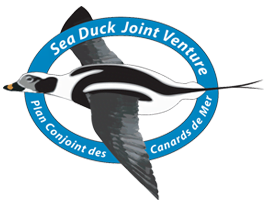Annual Request for Proposals
The SDJV does not currently have an open Request for Proposals. Please check back periodically for updates; when an RFP is open we will post it here and announce it through our newsletter (sign up at the bottom of this page under “E-news signup”).
For reference, the 2025 Request for Proposals announcement can be found on grants.gov and in this .pdf document.
Contact Kate Martin, US SDJV Coordinator, at with questions about the application process, budget template, or SDJV priorities.
Current Priorities
The SDJV’s FY25 Research Priorities are listed below and in this .pdf document. The SDJV has evolved from a broad science program aimed at basic understanding of this least-known group of waterfowl species, to a program focused on specific elements most needed by managers to make informed decisions about sea duck conservation.
The Sea Duck Joint Venture (SDJV) is requesting proposals that directly address the following research priorities. Proposals focused on SDJV high priority species will be prioritized. SDJV considers the following species high priority because of the magnitude of information needs of each given an assessment of available information and predicted current/future stressors: Common Eider, King Eider, White-winged Scoter, Black Scoter, Surf Scoter, Harlequin Duck, Long-tailed Duck, and Barrow’s Goldeneye.
Research Priorities (not listed in order of importance):
1. Information on migratory connectivity of sea ducks to improve survey design, harvest management and development of conservation actions. New studies could target geographic gaps from previous satellite telemetry studies or analyze existing datasets. Priorities include but are not limited to large-scale projects that provide information on population delineation (Pacific vs. Atlantic) for species where populations overlap, and projects focusing on priority sea duck species, particularly Long-tailed Ducks and King Eiders.
2. Studies that use Indigenous Knowledge to inform broad questions about sea duck ecology and management related to SDJV priorities. Projects that are co-produced with Indigenous partners are encouraged.
3. Studies focused on estimating rates of fecundity and survival of priority sea duck species. Modeling studies that identify and/or address information gaps, and studies refining alternative methods such as using photographic surveys to estimate sex and/or age ratios, are encouraged. Large-scale projects focused on investigating factors that influence these demographic parameters and provide information to inform harvest estimates and population-level management decisions will be prioritized.
4. Projects that characterize habitat use of priority species. Desired products include but are not limited to (a) estimates of energetic demands or time activity budgets for molting or wintering sea ducks to inform future estimates of landscape carrying capacity and (b) habitat suitability models. Projects that directly contribute to management or conservation of key sites identified in the Sea Duck Key Habitat Sites Atlas are encouraged.
5. Studies to determine effects of anthropogenic activities on sea duck populations. This may include (a) evaluation of the effects of industrial development (e.g., wind energy, mariculture, oil and gas development, vessel traffic, sand mining, contaminants) on sea ducks, and/or (b) development and testing of potential methods to reduce negative effects of these activities on sea ducks.
6. Studies that evaluate and predict effects of climate change on sea ducks, including changes in northern breeding areas and coastal habitats, altered phenology of life history patterns, changes in food resources and predator communities, and other conditions that degrade or enhance productivity and survival.
7. Evaluations of the effects of disease or parasites on sea duck populations.
8. Studies that improve our understanding of the viewpoints of various stakeholders in sea duck conservation to inform conservation and management actions. This could include an assessment of the values, concerns and behaviors of birdwatchers, the waterfowl management community, habitat joint ventures, hunters, hunting guides/outfitters, Indigenous communities and organizations, and other groups.
9. Studies that provide estimates of the size and composition of general and subsistence sea duck harvest such that the information could be incorporated into population models and management plans. This may include assessments of the derivation and distribution of sea duck harvest and how harvest is changing over time.
10. Assessments of the effect of changing predator communities (e.g., bald eagle, polar bear, mink, fox) on sea duck foraging behavior, breeding success, diurnal and long-term distribution patterns, and the effects of potential distribution shifts on the interpretation of survey data from long-term monitoring studies.
11. The development of new techniques or technologies that advance our ability to address the research priorities above.
Current Projects
Projects funded by the SDJV in FY2015 [PDF]
Projects funded by the SDJV in FY2016 [PDF]
Projects funded by the SDJV in FY2017 [PDF]
Projects funded by the SDJV in FY2018 – 2020 [PDF]
Projects funded by the SDJV in FY2021 [PDF]
Projects funded by the SDJV in FY2022 [PDF]
Projects funded by the SDJV in FY2023 [PDF]
Projects funded by the SDJV in FY2024 [PDF]
